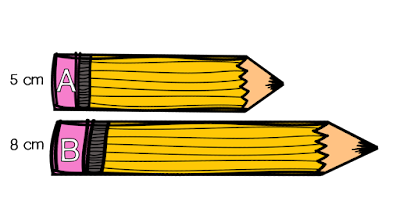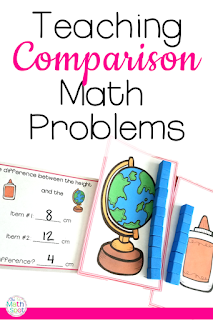This post contains affiliate links. This means that when you make a purchase, at no additional cost to you, I will earn a small commission.
Why is it that comparison word problems are particularly difficult for elementary school students?
There are several challenges present in these specific types of word problems that we don’t have to contend with when we are doing more simple problem types such as put together, take apart, add to, or take from word problems!

Challenge #1: Vocabulary
There are some specific vocabulary challenges around comparison word problems. A bit of vocabulary work with your students pointing out these challenges will help them go far when solving comparison word problems.

Show a picture of two different pencils, each with a measurement written alongside. Ask your students “How much longer is pencil B than pencil A?” I will bet that a large percentage of your class will tell you the length of pencil B rather than how much longer pencil B is!
Now try to ask this question differently. First, ask the students
How long is pencil A?
How long is pencil B?
…I’ll bet that all of your students get these answers correct!
Now, ask your students which pencil is longer. Once they identify that pencil B is longer, ask How much longer?
More of your students will get this question correct than the original question because you have walked them through the difference between long and longer. Those two letters hold so much weight and meaning but are often overlooked by students!
Now, vocabulary challenges aside, this math concept is difficult and I am still sure that there are a group of students who we still need to help.
Challenge #2: These Problems are Abstract
The second main difficulty with this type of problem is that a comparison is an abstract amount that doesn’t necessarily exist! The number of centimeters fewer is not something our students can see or touch, it’s an abstract concept.

Lay centimeter cubes along the length of pencil A and pencil B. Ask your students again,
How long is pencil A?
How long is pencil B?
Which pencil is longer?
How much longer?
This time, with the concrete modeling, many more of your students will be able to see how much longer pencil B is then pencil A!
If you need to make this even more clear, push the two pencils together so that the centimeter cubes are right alongside one another. Your students can see pencil A and pencil B are the same up to 5 cm but pencil B has one, two, three more centimeters than pencil A. Pencil B is 3 centimeters longer!
At this point many or most of your students will be very successful with the comparison language, however… You don’t want them to be at the concrete stage forever so, what can we do? We can use a part part whole diagram to represent the same thinking.

You can see above that when we draw a pencil A as a box and pencil B as a box we can use a dotted line to show the difference between the two.
At this point, the diagram makes it very clear that pencil A and the difference put together are the same as the length as pencil B. Your students can write a missing addend equation to solve for the part that shows the difference in the length of the pencils.
What Are The Next Steps?
This will still be a difficult concept for your students! Don’t expect them to learn the skill overnight. Most of your students will need extensive hands-on practice linked to the part-part-whole diagram many, many times before this will be an internalized understanding.
At this point, your students have done vocabulary work and have expanded their math understanding and they will be much more successful with comparison word problems!
Looking for “Done For You” resources to teach this tricky skill?
- Kindergarten Comparison Cards (free)
- 1st Grade Comparison Word Problems Unit
- 3rd Grade Comparison Word Problems in Data





